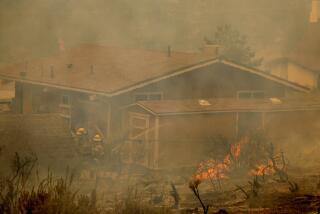Forest ‘Health’ Via the Saw
Now that the U.S. House of Representatives has uncritically approved President Bush’s misnamed “Healthy Forests” initiative, which really is a new logging program under the guise of fire safety in the national forests, it’s up to the Senate to halt this bad bill.
What the West needs is an effort by federal, state and local governments and others to thin those forests that present the greatest threat -- to people, homes, ranches and other development and to critical watersheds. Some of those forests, but far from all of them, are on federal lands. Many of them, especially in California, are privately owned or held by the state.
A worthwhile plan already exists, the 10-year comprehensive wildfire strategy developed by the Western Governors’ Assn. and President Clinton after the disastrous fire that burned into the city of Los Alamos, N.M., in 2000. Essential parts of that plan are in a bill sponsored by Rep. George Miller (D-Martinez) that was rejected by the House. Much of the strategy can be put in effect without legislation. Some of it is underway.
In California, after 10 years of study and discussion, the U.S. Forest Service adopted the Sierra Nevada Framework, which contains workable protection for Mother Lode towns and other areas where fire danger is the highest. State and local officials and other interests developed this good plan. Unfortunately, the Forest Service is backing away from it to allow, among other things, more commercial logging.
As with the Bush plan, approved by the House last week, the justification for the logging is that it’s needed to raise the money to pay for the thinning work: We have to cut the forests to save them. But if people are in danger, Congress should appropriate the money to do the job now rather than waiting until the logging is done.
The Bush plan -- in one of its worst aspects -- also severely limits the public’s right to challenge timber-cutting plans, or to offer alternatives. It makes taking suspect plans to court far more difficult.
The administration claims that timber-cutting programs are dangerously delayed by administrative appeals and lawsuits. But this is a misconception, exposed more than once by the General Accounting Office, Congress’ investigating agency. The GAO found that more than 95% of 762 fuel-clearing projects covering 4.7 million acres were implemented by the end of a standard 90-day review. Lawsuits were filed in only 3% of the projects.
There’s nothing wrong with the president using the emotion of last year’s disastrous fires to win legislation to make people safer. Unfortunately, the House bill carries no assurance of that.
More to Read
Sign up for The Wild
We’ll help you find the best places to hike, bike and run, as well as the perfect silent spots for meditation and yoga.
You may occasionally receive promotional content from the Los Angeles Times.






